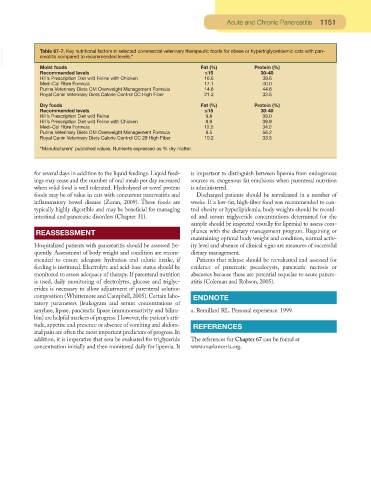Page 1106 - Small Animal Clinical Nutrition 5th Edition
P. 1106
Acute and Chronic Pancreatitis 1151
VetBooks.ir Table 67-7. Key nutritional factors in selected commercial veterinary therapeutic foods for obese or hypertriglyceridemic cats with pan-
creatitis compared to recommended levels.*
Moist foods
≤15
30-40
Recommended levels Fat (%) Protein (%)
Hill’s Prescription Diet w/d Feline with Chicken 16.6 39.6
Medi-Cal Fibre Formula 17.1 40.0
Purina Veterinary Diets OM Overweight Management Formula 14.6 44.6
Royal Canin Veterinary Diets Calorie Control CC High Fiber 21.3 33.5
Dry foods Fat (%) Protein (%)
Recommended levels ≤15 30-40
Hill’s Prescription Diet w/d Feline 9.8 39.0
Hill’s Prescription Diet w/d Feline with Chicken 9.9 39.9
Medi-Cal Fibre Formula 12.2 34.2
Purina Veterinary Diets OM Overweight Management Formula 8.5 56.2
Royal Canin Veterinary Diets Calorie Control CC 29 High Fiber 10.2 33.5
*Manufacturers’ published values. Nutrients expressed as % dry matter.
for several days in addition to the liquid feedings. Liquid feed- is important to distinguish between lipemia from endogenous
ings may cease and the number of oral meals per day increased sources vs. exogenous fat emulsions when parenteral nutrition
when solid food is well tolerated. Hydrolyzed or novel protein is administered.
foods may be of value in cats with concurrent pancreatitis and Discharged patients should be reevaluated in a number of
inflammatory bowel disease (Zoran, 2009). These foods are weeks. If a low-fat, high-fiber food was recommended to con-
typically highly digestible and may be beneficial for managing trol obesity or hyperlipidemia, body weights should be record-
intestinal and pancreatic disorders (Chapter 31). ed and serum triglyceride concentrations determined (or the
sample should be inspected visually for lipemia) to assess com-
REASSESSMENT pliance with the dietary management program. Regaining or
maintaining optimal body weight and condition, normal activ-
Hospitalized patients with pancreatitis should be assessed fre- ity level and absence of clinical signs are measures of successful
quently. Assessment of body weight and condition are recom- dietary management.
mended to ensure adequate hydration and caloric intake, if Patients that relapse should be reevaluated and assessed for
feeding is instituted. Electrolyte and acid-base status should be evidence of pancreatic pseudocysts, pancreatic necrosis or
monitored to assess adequacy of therapy. If parenteral nutrition abscesses because these are potential sequelae to acute pancre-
is used, daily monitoring of electrolytes, glucose and triglyc- atitis (Coleman and Robson, 2005).
erides is necessary to allow adjustment of parenteral solution
composition (Whittemore and Campbell, 2005). Certain labo- ENDNOTE
ratory parameters (leukogram and serum concentrations of
amylase, lipase, pancreatic lipase immunoreactivity and biliru- a. Remillard RL. Personal experience. 1999.
bin) are helpful markers of progress. However,the patient’s atti-
tude, appetite and presence or absence of vomiting and abdom- REFERENCES
inal pain are often the most important predictors of progress. In
addition, it is imperative that sera be evaluated for triglyceride The references for Chapter 67 can be found at
concentration initially and then monitored daily for lipemia. It www.markmorris.org.

